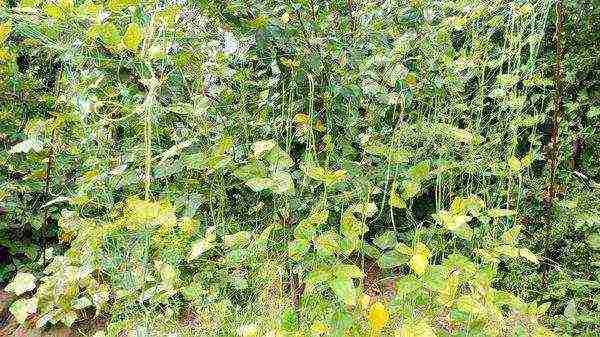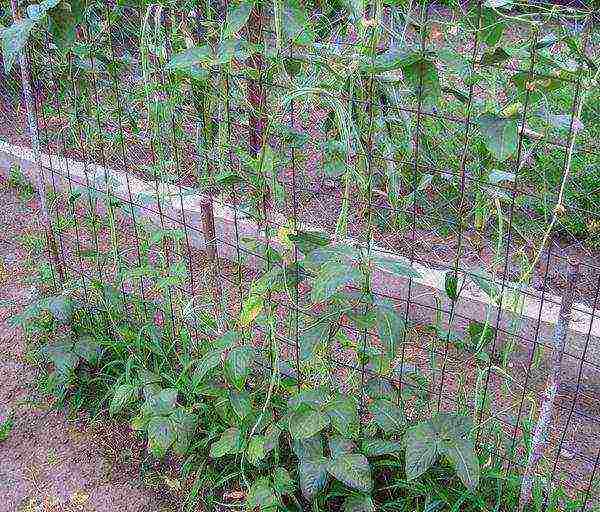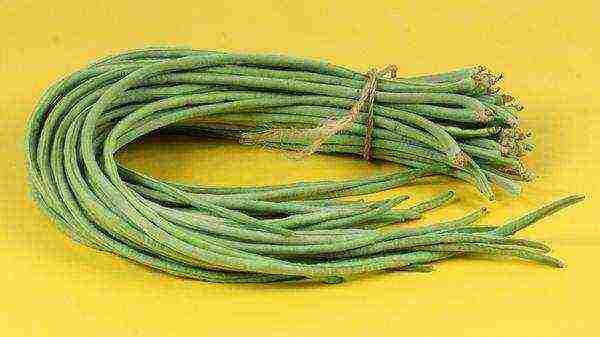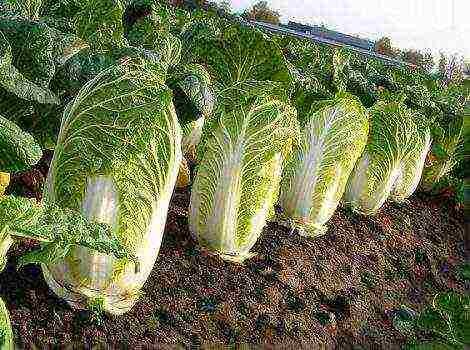Content
Proper cultivation of cowpea vegetable or asparagus beans
Every year more and more crops appear for cultivation in personal plots. Plants of southern countries, through the efforts of biologists, acquire a new homeland. Vigna vegetable is a pleasant novelty for amateur gardeners in Russia. With proper care, cultivation in the open field is possible in the Urals and in the Moscow region.
Description of vegetable cowpea
Resembles asparagus beans, but does not belong to this species. Does not interbreed with beans. Herbaceous annual plant, can be a shrub, short or tall, or climbing. Very beautiful during flowering.
Creepers grow stalks up to 3-4 meters, the brushes have shoulder blades, about a meter long, pencil-thick. Yield up to 3 kg of beans per bush.
This vine, at the time of reaching its maximum yield, is quite heavy. Requires solid support. Beautiful, entwined with a plant, a terrace, a balcony, a gazebo.

The main characteristics of the culture
Several species of cowpea are known. These are Korean, Vietnamese, Chinese and Japanese. The Chinese made the culture popular at home, bred asparagus varieties with long blades, tender without hard veins. Then it spread throughout the world.
Vigna vegetable was cultivated in the southern regions, it thermophilic... Thanks to the work of breeders, the growing area has expanded. In the central and western regions of Russia, early varieties are grown by seedlings or in greenhouses in the vicinity of cucumbers.
By eating beans in food, we enrich the body with the necessary microelements, as well as vitamins B, C, D... Arginine contained in fruits normalizes hemoglobin in the blood, treats diabetes mellitus and high blood pressure. The presence of potassium and sodium promotes the elimination of excess fluid, reduces edema. The pods can be dried and made into a healthy tea.
Popular varieties
Most interesting for gardeners asparagus varieties, the beans do not have a hard fiber, with a delicate flavor.
- Macaretti
- Countess
- Macaretti - a variety of medium ripening. Already 80 days after germination, the mass collection of beans begins. Scourges up to three meters long. Curved pods, 30 cm long, green, tender. The seeds are brown. Productivity up to 2 kg per bush.
- Countess - an early fruitful variety. The first fruits can be harvested 65 days after the start of mass shoots. Liana curls up to 3 m, beans 50 cm long. Delicate pods do not contain fibers. The seeds are black. Up to 2.5 kg of grain is harvested from a square meter of a garden bed.
- Korean - early bush variety. Beans 10-12 cm long. Compact shrub, does not require much space for growing.
Planting and growing outdoors
Planting includes the preparation of beds and seed.
Garden bed preparation
The origin of cowpea determines the conditions for its cultivation. The plant requires bright, sheltered from the wind... Does not tolerate acidic and moist soils.

In the fall, the garden bed is dug up, humus and compost are added, superphosphate is added. In the spring, re-loosening is performed, complex fertilizer is added. The plant impoverishes the soil, it is planted in the same place 3 years later.
Seed preparation and sowing
Seeds soaked in a solution of potassium permanganate for 20 minutes, then washed.You can preheat the grains in warm water. A good result is obtained by soaking in a solution "Phytocide", "Fitosporin".
They are planted in a pot in moist, heated ground three seeds each... The depth of the planting is 1 cm. For the first time, I cover the pot with glass to preserve moisture, and put it on the south window. Seeds germinate at a temperature not lower than 15 degrees.
Water the ground regularly until the first four leaves appear... Then cut. In the first month of growth, the plants are not fed. Planting is carried out 35 days before planting seedlings in the ground. Usually, seedlings are planted in the end of April.

Transplanting
Garden bed moisturize well... Plants are planted in rows at a distance 65 cm... The spacing is done 80 cm.
The bed is mulched and covered with foil on the established arcs. After reaching an average temperature of +15 degrees, the shelter is removed.
You can plant cowpea straight into the ground... Seeds are sown from May 20 in holes to a depth of 5 cm, three seeds each. When receiving seedlings, one plant is left. At an early stage, the culture is covered.
Plant care during the growing season
As usual, this is watering, feeding, loosening, weeding. Vigna - plant drought tolerant... Necessarily needed to water when buds appear, loosen after the seedlings reach a height of 7 cm.

Top dressing combined with watering. 5 g of potassium chloride, 15 g of superphosphate are added to a bucket of water, 100 g of ash is suitable instead of potassium. Along the row, a furrow is made 5 cm deep, spilled with a fertilizer solution, then mulched with earth and loosened.
For climbing varieties of cowpea set supports... For this purpose, you can use a cucumber net stretched over the frame. When the vine grows to 2.5 m, you need to pinch it. This will speed up the ripening of the fruit.
Harvesting and storage of crops
Harvesting cowpea beans on the shoulder begin 10 days after their formation... They reach milky ripeness, become juicy and fleshy. Collecting fruits contributes to the growth of new ones. During massive growth, the crop is harvested every three days.

If the plant is grown for grain, the beans must be ripe and the pods must dry. The grains are husked, dried and stored in a cool dry place.
Seed germination is maintained up to 5 years.
Vigna in cooking
Cowpea seeds boil well, they are used in salads, soups and sauces. After defrosting, delicate shoulder blades make delicious side dishes. Product contains more protein than fish and meat... Like all vegetables, it is low in calories and contains a lot of fiber. Sprouted grains are used for dietary nutrition.
Vigna is a relatively new vegetable crop for Russia. But its popularity is growing. The development of regionalized varieties has made it a less exotic and problematic crop for our climate. Considering the beneficial properties, it is worth trying to grow this vegetable in your garden.


